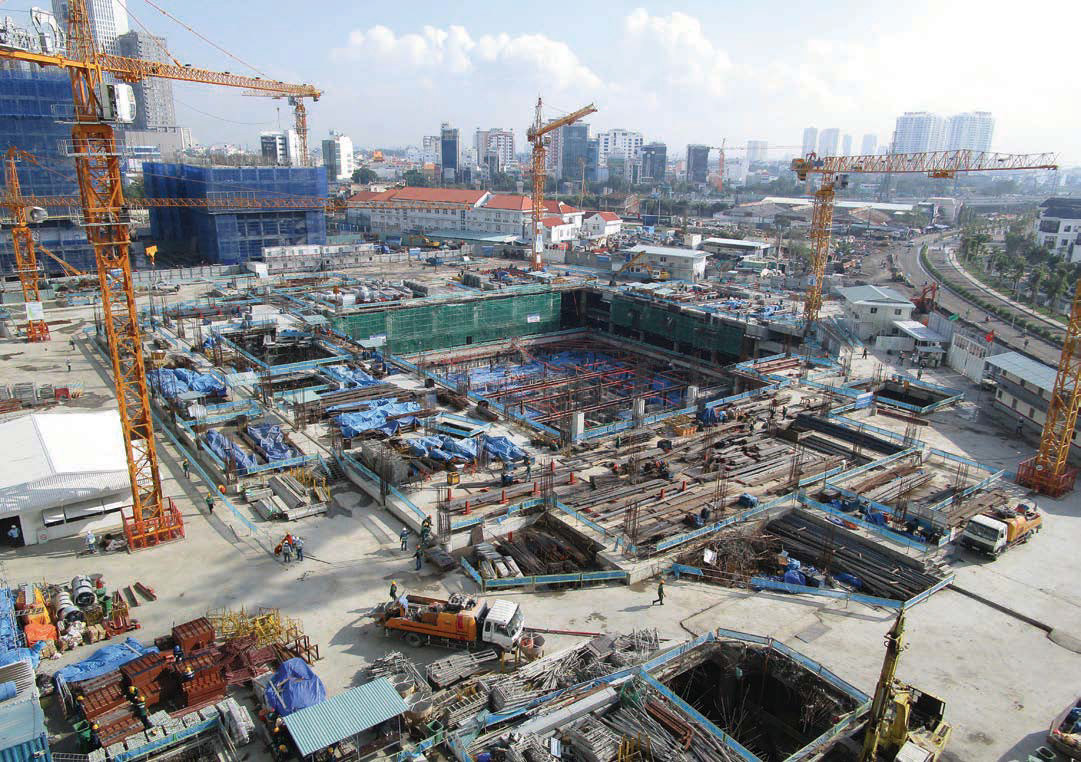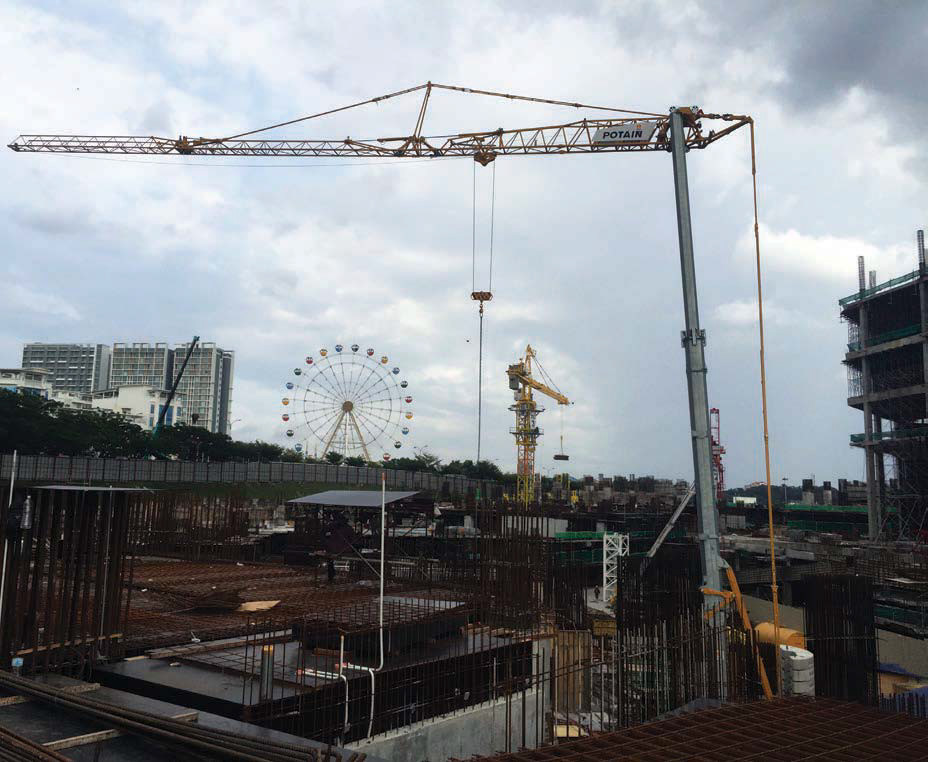A lion among tigers
21 January 2019Manitowoc’s Southeast Asia headquarters are in the ‘Lion City’ of Singapore, where the manufacturer is devising a strategy for boosting business in a fi ercely-competitive region. Sotiris Kanaris visited the company, and spoke to sales director Marco Zucchet.
The Southeast Asia market includes countries at various stages of economic development, with different languages, currencies and regulations. Under these circumstances a general regional strategy would be ineffective. Therefore, manufacturers are looking into ways to penetrate each market individually.
Apart from the offi ce in Singapore, Manitowoc has established offi ces in the Philippines and Korea. For tower cranes, dealers cover the rest of the region while, for mobile cranes, the manufacturer has dealers in some countries and sells directly to clients in others.
The establishment of a tower crane factory in Zhangjiagang, China, has allowed the manufacturer to better address the needs of customers in the region. During the latest Bauma China trade show, Manitowoc presented for the fi rst time a crane developed specifi cally for the Asian market, that is to say one that does not have a European “counterpart”.
The MCT 565, Potain’s largest topless crane, has three versions with maximum capacities of 20t, 25t and 32t. It was designed in response to a higher demand for larger capacity cranes to lift heavier precast concrete elements in some countries of the region, including Singapore, Hong Kong and South Korea.
Marco Zucchet, sales director for mobile and tower cranes in rest of Asia (Asean)—that is, all countries in the region other than China. He comments on the launch: “This is the fi rst example, following the appointment of new management led by Brian Wang, senior vice president for Asia Pacifi c, of the way we try to forge a closer connection with the local markets and customers. In the past we had a copy-and-paste mentality. We had a product that would be working well in Europe and we’d replicate it at our factories in Zhangjiagang. But this doesn’t seem to work anymore. The markets are different; in Europe cranes are not typically expected to lift loads of 32t but, in certain Asian countries, even 25t is not big enough.”
He says topless tower cranes are the best-selling range in the region, which is why the company is investing in new models. He sees the demand for hammerhead cranes dropping. “For congested job sites, topless cranes are a better solution than hammerheads. Of course, there are still markets that like hammerhead cranes. For example, the MC 310 enjoys great popularity in South Korea, where we have sold hundreds of units over the years.”
Another trend that Zucchet identifi es is the increased popularity of luffi ng jib cranes, especially in the big urban centres of the region. “Even in traditional markets like Vietnam where luffi ng jib cranes used to account for one or two out of ten tower cranes, there has been a notable increase. Now, they comprise four out of every ten tower cranes sold. Cities like Hanoi, Bangkok, Kuala Lumpur are becoming congested, so the luffing jib cranes are gaining more popularity there.”
To meet this demand, Manitowoc has expanded its range. It has introduced the Potain MCH 125 hydraulic luffing jib crane and the Potain MCR 295 luffing jib crane. Zucchet says the manufacturer will soon introduce another hydraulic luffing jib crane, the MCH 175.
As for the expectations for future tower crane sales, Zucchet says: “The market was extremely soft in Singapore. The extremely low rental price had an adverse effect on investment in new machines. Now, rental prices are picking up and the government is trying to stimulate construction of private buildings mainly, so we anticipate an increase in demand in Singapore for 2019/2020.”
He expects demand for tower cranes to stabilise in Thailand, Malaysia and Vietnam. “Indonesia is a big question mark at this stage. They will have elections in 2019, so a lot of the industry players will sit and wait. The Indonesian rupiah fell by 15–20% against the dollar over the last year and that is affecting the buying power of our customers. Currency fluctuations is a reason why even in countries where construction is booming, players are not investing in new equipment as much as they would like to.”
Apart from the currency, in some countries, high import tax also affects the price of machines from European and American manufacturers. Zucchet says Japanese manufacturers pay a fraction of the tax and this has an impact in market competition.
“In terms of crawlers, due to the ending of our agreement with Kobelco, we will not supply the previously successful 80t and 100t crawler cranes, anymore.” However he says the newly-introduced 100t MLC100-1 will be a great product for the region and that the heavier capacity crawlers are extremely successful.
The Manitowoc MLC650 features a variable position counterweight, of which he says: “Customers using them in South Korea and Australia are extremely satisfied with their performance and lower logistics costs. Moving around a traditional crane requires at least 25–30% more containers, and it’s cheaper to prepare the ground for the MLC650 because of the smaller surface area it occupies. It’s also faster to set up the MLC650, so there are a lot of economical advantages.”
The all-terrain crane market, like the tower crane market, has had an increase in demand for higher capacity machines. Zucchet says many crane owners have shifted from 200t to 250t and 300t machines, with the six-axle 300t Grove GMK6300L being particularly successful. Manitowoc has also seen many fleet owners replacing 80t ATs with 100t capacity GMK4100L.
And in line with its vision of continuous development, Manitowoc has recently launched the GMK6300L-1, which is an upgraded version of the already strong 300t crane, with many of the newer innovations that have increased capacities even further.
And that’s not all according to Zucchet, “We have stopped production of the GMK4100L, and have replaced it with the GMK4100L-1—a stronger crane than its predecessor.
“The engine we use is extremely reliable, so having one engine means less maintenance, less spare parts, less hydraulic problems, and a more compact and efficient crane with lower fuel consumption.”
The most competitive market according to Zucchet is the rough terrain one, which has Japanese players to compete with. He says the newly launched GRT 880 and GRT8100, now manufactured in Manitowoc’s manufacturing facility in Niella Tenaro, are extremely good products for the market.
As mining and oil and gas industries in Asia Pacific are recovering, Zucchet feels there will be a greater demand for rough terrain cranes over the next couple of years.
In terms of the mobile crane market as a whole, Zucchet expects the market to pick up in Southeast Asia, mainly from fleet renewal and investment projects such as infrastructure and refineries.
The near future may seem challenging with volatility of some economies, but Manitowoc is quite confident about the future as Zucchet concluded, “Manitowoc has invested in developing new products that fit market needs, and in an aftersales organization that could support our customers and dealers around the clock and around the region, so the future is looking better than ever.”

